One form of the disease begins with large open sores that won’t heal, then migrates to the nose and lips, rotting them away like a form of leprosy and leaving the victim badly disfigured.
Another strain isn’t nearly as visibly grotesque, but it’s far more deadly, attacking the spleen, liver, and bone marrow.
The deadly strain of the disease, visceral leishmaniasis, infects 300,000 people annually, causing 20,000 deaths, according to the World Health Organization. It is the second largest cause of parasitic death after malaria. Another 1 million people are infected with cutaneous leishmaniasis annually and more than 500 million people worldwide are at risk for contracting some form of the disease.
You may wonder why you’ve never heard of such a horrid, deadly, and widespread disease.
The answer is simple—it’s a tropical disease suffered primarily by the most impoverished populations in the world. While it poses a risk to American soldiers, researchers, and adventure travelers, the vast majority of cases are found among rural populations in equatorial countries. So for most of the developed world, leishmaniasis is a distant threat.
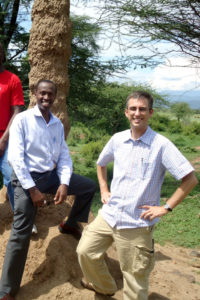 But for two Northeastern professors, Richard Wamai and Michael Pollastri, controlling the disease is a top priority. The two co-founded the Integrated Initiative for Global Health at Northeastern to spearhead their interdisciplinary work on neglected diseases.
But for two Northeastern professors, Richard Wamai and Michael Pollastri, controlling the disease is a top priority. The two co-founded the Integrated Initiative for Global Health at Northeastern to spearhead their interdisciplinary work on neglected diseases.
Wamai, an expert in global health, is building a research center in rural Kenya, where he has been conducting research on leishmaniasis for the past eight years. Kenya is one of the seven countries that account for 90 percent of the reported cases of the disease. To advance experiential learning at Northeastern, he has invited students to participate in many of his research trips to the African nation.
Pollastri is attacking the problem in his Northeastern lab, where he develops new medicines to combat neglected tropical diseases. Although the two men are approaching the disease from different disciplines, one as a social scientist and the other as a chemist, they are working collaboratively toward the same goal.
In 2011, Wamai and Pollastri received a $50,000 seed grant from Northeastern to conduct preliminary field research in Kenya needed to win major grants from the National Institutes of Health and other private sources.
“That experience is why my lab got so deeply into this,” said Pollastri. “People were walking 20 kilometers with their whole family to get tested. The kids who suffered from this disease were the same age as my kids, who were 9 and 4 at the time. This isn’t just some academic exercise. It’s as real as it gets.”
A personal mission
Wamai grew up in a rural Kenyan village with no electricity, running water, or indoor toilets. He didn’t have his first pair of shoes until he was 13, and like the other kids in his village, he ran barefoot to school each day. When the kids cut themselves working in the fields, they bound their wounds with dirt to stop the bleeding, which often caused more serious problems.
“Growing up, every little boy had intestinal worms at some point,” he said.

Michael Pollastri is an associate professor of medicinal chemistry and chemical technology researching new therapeutic drugs for neglected tropical diseases in the Egan Research Center. Photo by Brooks Canaday/Northeastern University
“Mothers would know because their children would be eating and not gaining weight.”
In 1983, at age 13, Wamai took the national test that Kenya administers to determine which children will continue their education.
“I was the top candidate in my district, so I went to a national boarding school 10 miles from my house,” he said. “That’s when I got my first pair of shoes and trousers.”
He did so well in school that he was transferred to an advanced academy 300 miles from his home near the Somali border. That eventually led to a degree in sociology at the Egerton University in Kenya and a doctorate in international health at the University of Helsinki in Finland.
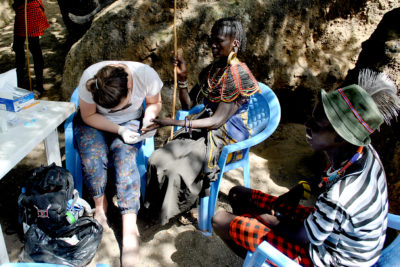
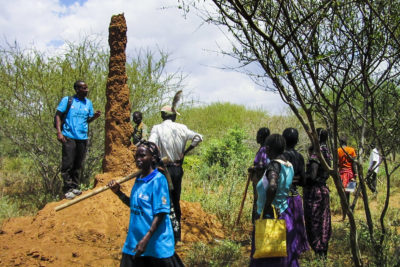
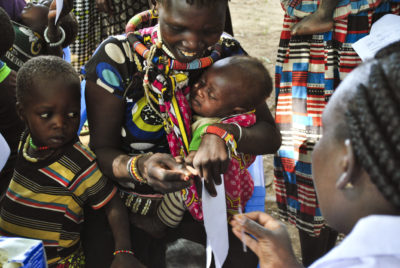
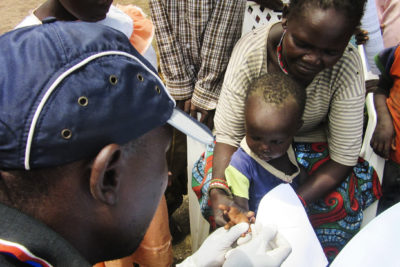
From top to bottom: Adrienne Orriols administers a leishmaniasis test to a local tribeswoman; Termite hills, which typically tower 10 feet, are a prime habitat for sand flies that spread diseases; Kenyan health volunteers administer Leishmaniasis tests to members of the Potok tribe. Photos courtesy of Adrienne Orriols.
“I had five brothers and three sisters, and although all of them went to college, I was the only one who ever left the country,” he said.
But Kenya has never been far from his mind.
Following research appointments at Harvard, Oxford, the London School of Economics, and Johns Hopkins universities, Wamai came to Northeastern in 2009 to continue his research on AIDS prevention in Africa. In addition to his teaching and research duties, he serves as director of the university’s African American Studies program.
And for the past eight years, he has been building partnerships to support his field research on leishmaniasis in Kenya.
Into the field
The SUV kicked up plumes of dust as it raced across the roadless Kenyan landscape.
Riding along with Wamai were two undergraduates, Grace Grifferty and Adrienne Orriols. The roads were fine for the first six hours from Nairobi to Chemolingot, but the final 40 kilometers would be across an arid landscape sparsely populated by nomadic tribes.
“There were no roads—just dust, sand, and dirt,” said Grifferty, a molecular biology major due to graduate in 2019. “We had to follow tire tracks.”
The trio was on a mission in December 2017 to provide education and disease screening to the Potok tribe that calls this swath of northern Kenya home. Because there was no cluster of houses, Wamai had worked with tribal leaders to identify a meeting place.
“It would often be somewhere they take their cattle to graze—under a large tree, along a riverbank,” said Wamai.
The only buildings were huts made of sticks and mud—temporary shelters built by people who don’t stay in one place for long. Working with a few Kenyan healthcare workers, they erected information posters—written in Swahili and the local Potok language—and set up tables where they would provide screening for leishmaniasis and two dozen other diseases.
“Soon there was a flood of people,” said Grifferty. “Many of them had walked miles to get medical care for their children.”
Leishmaniasis is transmitted to people by sand flies, which are found throughout the tropics. In Kenya, they’re a particular threat to children in rural areas who love to play around the strange termite towers that soar 10 feet or more above the arid ground. Sand flies often take over abandoned termite towers, which means the kids who play near them are constantly at risk of being bitten.
Another challenge is the huts themselves. They’re often built quickly out of sticks and have countless spaces in the walls that let in the bugs, which, unlike mosquitoes, fly silently. Wamai’s research found that huts with cooking fires have few sand flies, but with temperatures hovering around 100 degrees, people tend to cook and sleep outdoors. This is also why people often choose not to fill the spaces between the sticks with mud—it blocks the evening breeze.
Wamai’s research confirmed another Catch 22—poverty and malnutrition contribute significantly to leishmaniasis, but the destruction wrought by the disease prevents these populations from climbing out of poverty. It’s a vicious circle.
Another challenge is that the medications that work in other parts of the world are not effective on the Kenyan version of the disease, according to Pollastri. With no oral medicine, victims have to be transported to a hospital 50 miles away for either a 17-day or 30-day series of injections. Not only is this expensive, but tribal conflicts can make victims reluctant to accept treatment, Wamai said.
“The hospital is usually beyond their ethnic boundaries,” he said.
This is one of the reasons Pollastri is working diligently in his Northeastern lab to develop an oral treatment that will work in Kenya and elsewhere.
Bringing healthcare to the people
The absence of roads and long travel times make mobile clinics impractical, according to Wamai. Because the nearest health facility is not equipped to treat leishmaniasis, Wamai has been raising money to build a new wing and guesthouse for people suffering from the disease.
“We’ve done the initial education and field work, and now we need to set up a permanent presence,” he said.
Wamai is working with the Kenyan Ministry of Health, the University of Nairobi, and Baringo County to build the facility, which is being funded by the Izumi Foundation in Boston.
Richard Wamai, associate professor of cultures, societies and global studies and director of the African American Studies Program. Photo by Matthew Modoono/Northeastern University
The guest house has been completed and Wamai is now concentrating on fundraising efforts on the hospital wing and laboratory.
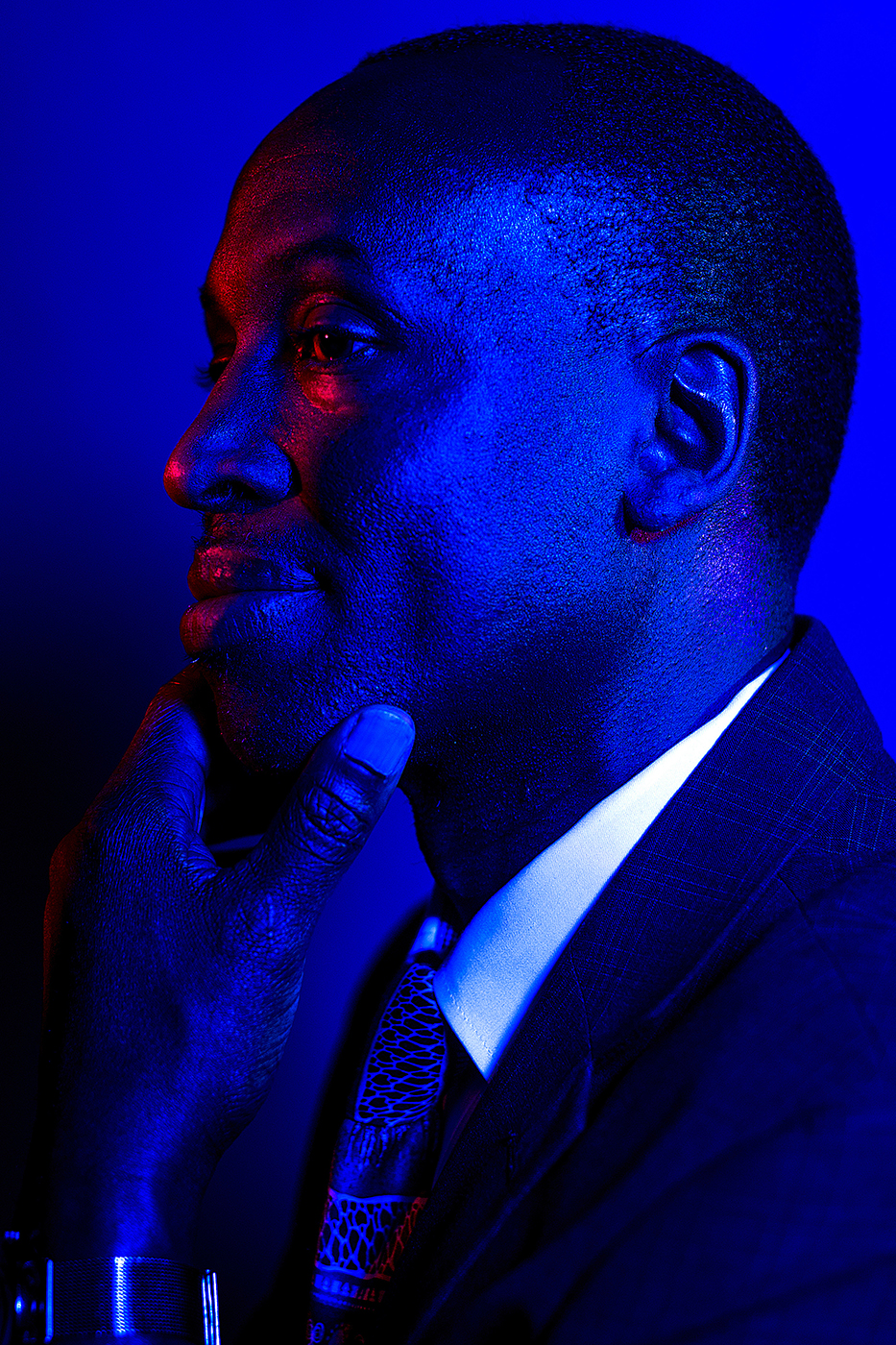
Back at Northeastern’s campus, Pollastri is working to find a cure. There is currently no vaccine, and the available medicines are almost as dangerous as the disease.
“The treatment that has been effective is antimonial drugs,” he said. “But antimony is just below arsenic on the periodic table and is very toxic.”
Pollastri said the cure will have to be a cocktail of several medications to slow the ability of the parasites to develop resistance.
“We’ve made hundreds of new compounds and several have met the criteria for treating the disease,” he said last week. “We will be testing them on mice in June.”
“We’re making progress, but it’s a super-challenging infection, and given that the parasite lives inside the host cells, a drug has to be able to penetrate the host cell and the parasite cell and only be toxic to the parasite.”
The power of experience
Grifferty won a grant from Northeastern, the Undergraduate Research and Creative Endeavors Award, to pay for her trip. When Orriols learned about her friend’s upcoming adventure, she decided to pay her own way.
“It was extremely eye opening,” said Orriols, a behavioral neuroscience major who expects to graduate in 2019. “I was planning to go to med school and wasn’t even thinking about global health. Now I’m thinking that I might want to get a master’s in public health. That was certainly nothing I had considered before.”
Grifferty also has her eyes on medical school, which she still intends to pursue. But she’s now thinking about combining her passion for surgery with a master’s in business, biotech, or global health.
“I see healthcare as a global issue,” she said. “It’s a perspective I gained from growing up overseas.”
Before coming to Northeastern, Grifferty lived in at least a half dozen countries, including Senegal, Kazakhstan, Georgia, Hungry, Somalia, and the United Arab Emirates.
“Going to Kenya with professor Wamai solidified my interest in global health,” she said. “Having that kind of impact on people meant a lot to me.”

